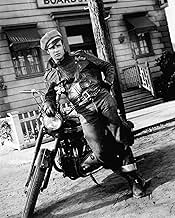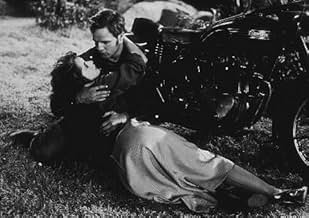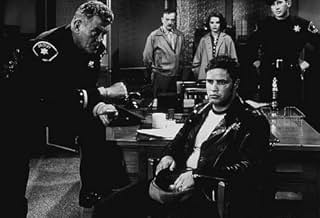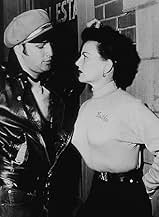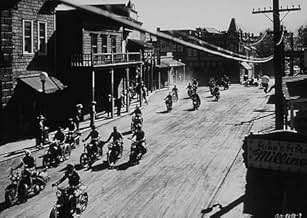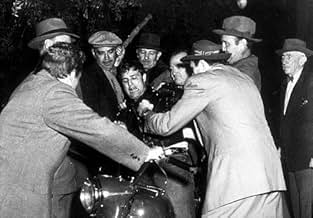IMDb रेटिंग
6.7/10
19 हज़ार
आपकी रेटिंग
अपनी भाषा में प्लॉट जोड़ेंTwo rival motorcycle gangs terrorize a small town after one of their leaders is thrown in jail.Two rival motorcycle gangs terrorize a small town after one of their leaders is thrown in jail.Two rival motorcycle gangs terrorize a small town after one of their leaders is thrown in jail.
Wally Albright
- Cyclist
- (बिना क्रेडिट के)
Chris Alcaide
- Deputy
- (बिना क्रेडिट के)
Don Anderson
- Stinger
- (बिना क्रेडिट के)
Robert Anderson
- Highway Patrolman at Sage Valley Race
- (बिना क्रेडिट के)
Robert Bice
- Wilson
- (बिना क्रेडिट के)
फ़ीचर्ड समीक्षाएं
Brando is his archetypal mean and moody self, as the original rebel on a motorcycle terrorising smalltown America. The enduring iconic images from the film have weathered better than the film itself, however, but it still stands up as a paean to disaffected youth.
When Johnny and the boys ride into town all hell breaks loose, with a culture clash between themselves and the 'squares', resulting in tragedy and some reconciliation. These boys look tame compared to today's standards (they even pay for their own beer!) but they don't fit in and so are immediately ostracised by a grown-up world that doesn't understand their jive-talking, anti-social behaviour. Johnny's reply when asked, "What are you rebelling against?" says it all..."Whatta you got?", with a sneer for good measure.
Time hasn't been kind to the film, and it's hard to see why it was banned in the UK for 18 years (mainly down to the lack of any retribution for the gang), but there is still a tight story and strong characterisation. It's a pity the film descends needlessly into melodrama, losing much of it's credibility in the process.
When Johnny and the boys ride into town all hell breaks loose, with a culture clash between themselves and the 'squares', resulting in tragedy and some reconciliation. These boys look tame compared to today's standards (they even pay for their own beer!) but they don't fit in and so are immediately ostracised by a grown-up world that doesn't understand their jive-talking, anti-social behaviour. Johnny's reply when asked, "What are you rebelling against?" says it all..."Whatta you got?", with a sneer for good measure.
Time hasn't been kind to the film, and it's hard to see why it was banned in the UK for 18 years (mainly down to the lack of any retribution for the gang), but there is still a tight story and strong characterisation. It's a pity the film descends needlessly into melodrama, losing much of it's credibility in the process.
A peaceable town is taken over by motorcycle rowdies.
Despite the sometimes frat boy antics of gang members, the movie came across to audiences of the time as something of a 50's nightmare. For example, there's a small town taken over by motorcycle outlaws, a virginal girl (Murphy) surrounded by rowdies, a cop too meek to intervene, and a general breakdown of peace, quiet and conformity. In short, it's a challenge to the every day norms the famously inarticulate Johnny (Brando) is rebelling against. It's that sort of restlessness that takes the gang to the highway, and the excitement they seek. But it's also a nation recovering from the rigors of a big Depression and the disruptions of WWII. So the two are bound to clash. The movie may seem tame by today's graphic standards, but for the 1950's it was a barbarian assault against the decade's defining conventions. No wonder, the film was condemned in so many places.
Truth be told, Brando doesn't act so much as he poses. Nonetheless, it's an iconic pose in cap and sunglasses that shot him to the forefront of the decade's celebrated rebels. For example, catch how delicately he positions the sunglasses or how he slouches silently by while others cavort. Still, the movie really comes alive when Lee Marvin (Chino) and his gang hit town. He's the loudmouth opposite of Johnny, looking to knock him off his regal pose, which he tries in a well-staged fistfight. Then there's Mary Murphy's good girl, a perfect casting choice. When she flees down a darkened street just ahead of the motorcycle rowdies, I could feel frozen shudders all over the theater of that day. It was like small town America about to be ravaged. Of course, the tables are turned when some of the town's bolder elements form into vigilantes and chase Johnny down the same street. I guess violence, as they say, really is a two-way street.
Anyway, the movie's still a milestone worth catching up with. My only gripe is with the cheapness of the production. The town and the sets are bare bones, especially in the movie's latter half. Maybe that was intentional in order to highlight the story. But if so, it came at the expense of a realistic undercurrent, especially the atrocious exterior set for Johnny and Kathie's little get-away, appearing more like a stage play than a film. All in all, it's a signature movie for the young Brando, cementing his rebel image for a generation.
Despite the sometimes frat boy antics of gang members, the movie came across to audiences of the time as something of a 50's nightmare. For example, there's a small town taken over by motorcycle outlaws, a virginal girl (Murphy) surrounded by rowdies, a cop too meek to intervene, and a general breakdown of peace, quiet and conformity. In short, it's a challenge to the every day norms the famously inarticulate Johnny (Brando) is rebelling against. It's that sort of restlessness that takes the gang to the highway, and the excitement they seek. But it's also a nation recovering from the rigors of a big Depression and the disruptions of WWII. So the two are bound to clash. The movie may seem tame by today's graphic standards, but for the 1950's it was a barbarian assault against the decade's defining conventions. No wonder, the film was condemned in so many places.
Truth be told, Brando doesn't act so much as he poses. Nonetheless, it's an iconic pose in cap and sunglasses that shot him to the forefront of the decade's celebrated rebels. For example, catch how delicately he positions the sunglasses or how he slouches silently by while others cavort. Still, the movie really comes alive when Lee Marvin (Chino) and his gang hit town. He's the loudmouth opposite of Johnny, looking to knock him off his regal pose, which he tries in a well-staged fistfight. Then there's Mary Murphy's good girl, a perfect casting choice. When she flees down a darkened street just ahead of the motorcycle rowdies, I could feel frozen shudders all over the theater of that day. It was like small town America about to be ravaged. Of course, the tables are turned when some of the town's bolder elements form into vigilantes and chase Johnny down the same street. I guess violence, as they say, really is a two-way street.
Anyway, the movie's still a milestone worth catching up with. My only gripe is with the cheapness of the production. The town and the sets are bare bones, especially in the movie's latter half. Maybe that was intentional in order to highlight the story. But if so, it came at the expense of a realistic undercurrent, especially the atrocious exterior set for Johnny and Kathie's little get-away, appearing more like a stage play than a film. All in all, it's a signature movie for the young Brando, cementing his rebel image for a generation.
MARLON BRANDO rides into town leading a pack of wild motorcycle riders who proceed to terrorize a hick town before LEE MARVIN shows up and gets into a drunken fight with Brando (as Johnny). Meantime, Johnny flirts dangerously with a cop's daughter (MARY MURPHY) who runs a cafe. Her father is played by ROBERT KEITH, a lawman who's reticent about using his authority with a bunch of motorcycle thugs.
Tension builds when Keith manages to haul Lee Marvin off to jail. Brando's buddies manage to get a hold of one of the town bullies and put him in the jail cell with the drunken Marvin who has passed out. They then go on a wild rampage but not before some of the town's men decide to form a vigilante squad and go after Brando. Brando has a brief romantic fling with the girl who realizes loving him is a lost cause.
***** POSSIBLE SPOILER AHEAD ***** The plot moves swiftly to a conclusion once the girl is able to convince the authorities that he wasn't responsible for the death of an elderly bystander hit by a motorcycle.
Stanley Kramer production has a nice, tense background score by Leith Stevens.
Summing up: Early Brando is impressive to watch, but much of the dialog is very dated and anchored firmly in the 1950s by the slang and be-bop expressions and overall concept of the film.
Famous for the moment when a girl taunts him with: "What are you rebelling against?"
Brando's terse reply: "What have you got?"
Tension builds when Keith manages to haul Lee Marvin off to jail. Brando's buddies manage to get a hold of one of the town bullies and put him in the jail cell with the drunken Marvin who has passed out. They then go on a wild rampage but not before some of the town's men decide to form a vigilante squad and go after Brando. Brando has a brief romantic fling with the girl who realizes loving him is a lost cause.
***** POSSIBLE SPOILER AHEAD ***** The plot moves swiftly to a conclusion once the girl is able to convince the authorities that he wasn't responsible for the death of an elderly bystander hit by a motorcycle.
Stanley Kramer production has a nice, tense background score by Leith Stevens.
Summing up: Early Brando is impressive to watch, but much of the dialog is very dated and anchored firmly in the 1950s by the slang and be-bop expressions and overall concept of the film.
Famous for the moment when a girl taunts him with: "What are you rebelling against?"
Brando's terse reply: "What have you got?"
Here we have THE original biker cinema classic that predated "Easy Rider" by a good decade and a half. Marlon Brando, all swaggering cool, delivers an iconic performance as Johnny, leader of the B.R.M.C. (Black Rebels Motorcycle Club). Johnny and friends come to a small town to raise some Hell; he becomes quite taken with local girl Kathie Bleeker (Mary Murphy), and she with him.
Although Johnny is no innocent, and does have a role to play in the events that get out of hand, it becomes clear that he's also not the Devil that hostile and intolerant citizens make him out to be.
"The Wild One" does firmly date itself in some ways. The dialogue is very much of the time, and the antics of these biker clubs are not as scuzzy as some people might like to see. This is not a biker film for those people who enjoy the exploitative low budget pictures that came out in the wake of "Easy Rider". After a while, it becomes clear that there's not that much of a story here, as a lot of mayhem and destruction takes up the running time. But then, this is just as much of a character study as it is a motorcycle movie.
Our main character is something of an enigma. While ostensibly a rebel in outright defiance of every accepted societal norm, he's also a guy who's really not that sure of himself, a guy still in search of an identity. Scenes late in the film with Johnny and Kathie are the real standouts.
The excellent cast also includes Robert Keith as Kathie's dad, a surprisingly laid back lawman who doesn't seem to be that cut out for his job, and who is willing to give our gang some amount of leeway. Lee Marvin steals his scenes as rival gang leader Chino. It's also fun to see people like Timothy Carey, Alvy Moore, Jerry Paris, and Bruno VeSota in small, uncredited roles.
Nicely shot (by Hal Mohr) and scored (by Leith Stevens), "The Wild One" does merit a viewing for film buffs.
Seven out of 10.
Although Johnny is no innocent, and does have a role to play in the events that get out of hand, it becomes clear that he's also not the Devil that hostile and intolerant citizens make him out to be.
"The Wild One" does firmly date itself in some ways. The dialogue is very much of the time, and the antics of these biker clubs are not as scuzzy as some people might like to see. This is not a biker film for those people who enjoy the exploitative low budget pictures that came out in the wake of "Easy Rider". After a while, it becomes clear that there's not that much of a story here, as a lot of mayhem and destruction takes up the running time. But then, this is just as much of a character study as it is a motorcycle movie.
Our main character is something of an enigma. While ostensibly a rebel in outright defiance of every accepted societal norm, he's also a guy who's really not that sure of himself, a guy still in search of an identity. Scenes late in the film with Johnny and Kathie are the real standouts.
The excellent cast also includes Robert Keith as Kathie's dad, a surprisingly laid back lawman who doesn't seem to be that cut out for his job, and who is willing to give our gang some amount of leeway. Lee Marvin steals his scenes as rival gang leader Chino. It's also fun to see people like Timothy Carey, Alvy Moore, Jerry Paris, and Bruno VeSota in small, uncredited roles.
Nicely shot (by Hal Mohr) and scored (by Leith Stevens), "The Wild One" does merit a viewing for film buffs.
Seven out of 10.
Although it might look quite tame compared to todays standards at the time of it's release The Wild One was considered ground breaking stuff which upset it's fair share of people (it was banned in Britain for 14 years). However it helped inspire the era of rebellion which lead to such classics as the James Dean epic Rebel Without a Cause. It is also memorable for Brando giving one of his greatest performances as Johnny Strabler, leader of the rebellious biker gang the "Black Rebels". True he didn't receive an academy award nomination for his role but there's still no doubting the standard of his performance.
At the start of the film we are introduced to Johnny and his gang as they interrupt a race taking place. This leads to a confrontation with the local sheriff which results in them leaving elsewhere to cause trouble. However just as they leave one of the members of the gang steals a trophy that would be presented to the runner up of the race (the first prize trophy was too big to steal)and gives it to Johnny. This represents the respect the gang has for Johnny. Soon after the gang arrives in the small town of Wrightsville, it is here that the film divides into two stories. The first one focuses on the relationship that develops between Johnny and a local girl called Kathie. At first it appears that the two couldn't be anymore different, he's a rebellious free spirit and she's lead quite a sheltered life going by rules and discipline. But it is through Kathie that we get to know the real Johnny as it is revealed that behind all the macho bravado he is quite a lost insecure soul unable to emotionally communicate with anyone, which explains why he behaves as he does. It is a credit to Brando's performance as to how he is able to draw sympathy from the viewer for his character. As Kathie has lead a sheltered life she has always been looking in from the outside, she has a father who is the sheriff of the town but isn't respected by the other residents and is considered something of a joke.It seems he is just there to make up the numbers and shows no signs of law enforcement skills when called to deal with a problem. Kathie sees him as a fraud, just as she sees Johnny. The second story focuses on the conflict that develops between the residents of the town and Johnny and his gang,during which it is the residents of the town who come off as the bad guys and not the black rebels.
As i previously mentioned while this film might look quite tame compared to todays standards it is still worth a look if you get a chance. If not to see what all the fuss was about at the time, then just for Brando's performance which really is in a league of it's own.
At the start of the film we are introduced to Johnny and his gang as they interrupt a race taking place. This leads to a confrontation with the local sheriff which results in them leaving elsewhere to cause trouble. However just as they leave one of the members of the gang steals a trophy that would be presented to the runner up of the race (the first prize trophy was too big to steal)and gives it to Johnny. This represents the respect the gang has for Johnny. Soon after the gang arrives in the small town of Wrightsville, it is here that the film divides into two stories. The first one focuses on the relationship that develops between Johnny and a local girl called Kathie. At first it appears that the two couldn't be anymore different, he's a rebellious free spirit and she's lead quite a sheltered life going by rules and discipline. But it is through Kathie that we get to know the real Johnny as it is revealed that behind all the macho bravado he is quite a lost insecure soul unable to emotionally communicate with anyone, which explains why he behaves as he does. It is a credit to Brando's performance as to how he is able to draw sympathy from the viewer for his character. As Kathie has lead a sheltered life she has always been looking in from the outside, she has a father who is the sheriff of the town but isn't respected by the other residents and is considered something of a joke.It seems he is just there to make up the numbers and shows no signs of law enforcement skills when called to deal with a problem. Kathie sees him as a fraud, just as she sees Johnny. The second story focuses on the conflict that develops between the residents of the town and Johnny and his gang,during which it is the residents of the town who come off as the bad guys and not the black rebels.
As i previously mentioned while this film might look quite tame compared to todays standards it is still worth a look if you get a chance. If not to see what all the fuss was about at the time, then just for Brando's performance which really is in a league of it's own.
क्या आपको पता है
- ट्रिवियाThe Triumph motorcycle that Marlon Brando rides in the movie was his personal bike.
- गूफ़At the completion of the opening credits, when the view switches to the wide shot of the pack preparing to make a left turn, the lead bike (Johnny) already has the trophy tied to the headlight. Johnny isn't presented with the stolen trophy until a later scene at the races.
- क्रेज़ी क्रेडिट[Opening credit] This is a shocking story. It could never take place in most American towns -- But it did in this one.
It is a public challenge not to let it happen again.
- कनेक्शनEdited into Heavy Petting (1989)
टॉप पसंद
रेटिंग देने के लिए साइन-इन करें और वैयक्तिकृत सुझावों के लिए वॉचलिस्ट करें
विवरण
- चलने की अवधि
- 1 घं 19 मि(79 min)
- रंग
- पक्ष अनुपात
- 1.37 : 1
इस पेज में योगदान दें
किसी बदलाव का सुझाव दें या अनुपलब्ध कॉन्टेंट जोड़ें





